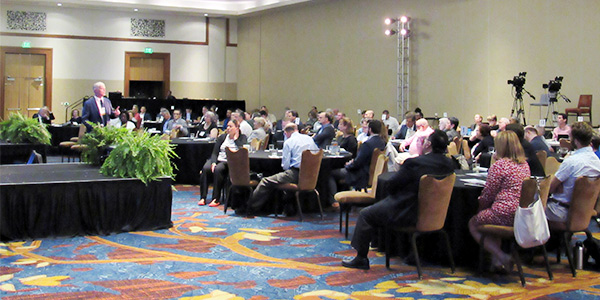By Amanda Durish Cook
INDIANAPOLIS — State regulators considered the impact of a prolonged blackout for about half the country during the National Association of Regulatory Utility Commissioners’ first-ever “black sky” exercise July 21.
The simulation, part of the 2019 Summer Policy Summit, focused on terrorist-originated electromagnetic pulses. John Heltzel, director of resilience planning for the Electric Infrastructure Security Council, said EMPs should not be dismissed as an obsolete Cold War-era threat. “There are real actors in the real world that are thinking of ways to disrupt us with EMP,” he said.
The EIS Council defines a black sky as a catastrophic event that severely disrupts critical infrastructure in multiple regions for a long period. Heltzel said other black sky causes are earthquakes, severe weather and geomagnetic disturbances. Heltzel said the earth is due for a powerful sun storm within the decade, with such storms able take down large regions of the electric grid.
Heltzel also pointed to the economic collapse of Venezuela as another blackout trigger. “They were back in the Stone Age. They were drawing buckets of water from streams to drink. No purification,” Heltzel warned.
He also cited the risks of climate change — whose urgency, he said, is not in question.
“I’m not going to debate something I feel is very obvious. … The fact is the number of natural disasters is increasing, that from a preparedness and resilience standpoint, we cannot afford to not take action. … We need to make these events survivable because they’re not going to change,” he said.
The exercise simulated an approximate six-month total blackout on the entire Eastern Interconnection in winter affecting about 100 million people. It featured videos of faux newscasts, boil water advisories, interviews with evacuees, casualty reports and chaotic Department of Homeland Security, Department of Defense and Federal Emergency Management Agency briefings. The players eventually learned the blackout was caused by an EMP attack from a ship in the Gulf of Mexico.
In the first hours of the event, New York City restaurants held “fire sales” to get rid of food before it spoiled.
The simulation touched on gridlocked expressways, first responder no-shows, water and gas shortages, hospital evacuations, sewage backups, riots, inoperable interstate fuel lines and burned out generators. It also imitated mass population migrations, makeshift shelter setups and aid convoys. Power restoration was scarce and spotty, mostly on the fringes of the affected area, with some power plants and transformers irrevocably damaged.
Heltzel said that as energy infrastructure becomes more interconnected, interdependencies are compounded, so the loss of one connected element “becomes rapidly, extremely difficult.”
In between video clips, Heltzel pointed out that most military bases aren’t equipped to be energy self-sufficient. He also noted that the one area that didn’t lose power during 2012’s Hurricane Sandy was microgrid-equipped Princeton University.
“Generators are a problem because everyone thinks they’re a panacea,” Heltzel said, noting that generators sent to Puerto Rico during Hurricane Maria in 2017 quickly ran out of fuel and became useless.
Puerto Rico Energy Bureau Associate Commissioner Lillian Mateo-Santos recounted paying her neighbor for use of his diesel-run generator in the weeks following the hurricane. She said she remembered people feeling overwhelmed by hopeless.
“Hopelessness erodes any effort from the government or aid organizations. … You’re stuck in that mode,” she said.
EIS Council staff at the conference called the hurricane a wake-up call.
Regulators in the audience said that during a blackout, a near-term goal should be to convince as many people as possible to shelter in place. Others said state agencies should set up mandatory attendance agreements with employees in advance.
Some regulators pointed out that a blackout could become a nuclear disaster as well, as cooling systems lacking power eventually fail.
Heltzel said his simulation and warnings aren’t cause for hopelessness. “We’re not the doom-and-gloom guys. We’re the optimists,” he said.
He urged regulators to develop emergency communication systems and action plans that include backup power systems in certain necessary areas and microgrid-equipped military bases. He also advised the installation of backup batteries for traffic lights on major evacuation routes.
Regulators should also call for emergency operating procedures from their utilities and create a prioritization of power needs so responders know where to direct generators and concentrate restoration efforts first, Heltzel said.
He also said only a handful of states have completed preparations under the Department of Homeland Security’s Power Outage Incident Annex, which advises federal responders on how to provide recovery for different localities within a state.
“Ask them if they’ve got a plan in place where every soldier and airman knows where to go,” Heltzel said, referring to National Guard leaders.




